|
|
 |
| |
|
| |
 Photo
essay: Photo
essay:
Vietnam Bicycle Tour: Imperial Roots (Central)
|
| |
|
An Khe – Pleibroum (70km, 44mi) self-contained ride and over-night stay in
E’de minority village.
Points of interest: Bahnar and E’de ethnic minorities, corn, cotton, Yangnam cemetary |
|
| |

|
Non-motorized transport is still
very common throughout the country. Around An Khe a lot of students
bicycle (left) and people use shoulder poles (right) to carry goods to and from
the market. |
 |
| |
 |
As the climate changes so does the
agriculture and so does the produce drying along the road. In the Central
Highlands you are more likely to see corn (left and right) or cassava. |
 |
| |

|
A common mode of travel for
traveling sales people in rural Vietnam is motorcycle. This woman (left)
came to the village in the morning with vegetables. At about the same time
a man is setting out in his boat (right). |
 |
| |
 |
This woman is washing pans near a
pond (left) surround by banana trees and other crops. Perhaps as a
substitute for newspapers, educational messages on billboards are a regular
sight
(right). |
 |
| |

|
Bana or Bahnar is an official ethnic
community in Viet Nam. The language is from the Mon-Khmer / Central
Bahnaric group. Generally the people live on and farm on mountain slope. Slash and burn agriculture, hunting,
gathering and
weaving made up the traditional lifestyle. Each village has a communial Rong
stilt house, where public activities are held, guests are received, and
unmarried men sleep at night. |
 |
| |
 |
Traditionally the Bana are
 matrilineal
but the system is fading. After the wedding a couple may go to the bride’s
parents, but they can later go to the grooms family. When a baby is one
month old, the parents hold a ceremony where the soul is introduced into the
child’s ear. matrilineal
but the system is fading. After the wedding a couple may go to the bride’s
parents, but they can later go to the grooms family. When a baby is one
month old, the parents hold a ceremony where the soul is introduced into the
child’s ear. |
 |
| |
 |
This gentleman is selling
traditional rice wine -- by the jug. |
|
| |

|
The school (left) and post office
(right) in Yangnam. Life changed a lot in Yangnam in 2004 when a new
road and power lines came to town. Even so, government employees in town
from other regions commented on feeling isolated. |
 |
| |

|
Late afternoon was when the school
teachers came to the well to bath and wash clothes (left). Some gave
the impression that they were more used to piped water systems than dropping a bucket
into the well and hauling it up. The typical housing in Yangnam (right)
is very modest traditional stilt homes. Traditional thatched roofs are very
rare. The houses generally have metal or tile roofs. |
 |
| |

|
Yangnam has a few significantly
larger and more affluent house. The business at one, and presumably a
profitable one, was making some kind of alcoholic beverage. |
 |
| |

 |
One of the place to hangout in
Yangnam is the combination restaurant, bar and pool hall (left). One person who
spent several hours there is the math teacher from the school (right). He
is also a guitarist. Vietnamese ethnic cultures are typically rich in oral
literature, with long poems, folktales and folk songs.
We asked for a simple lunch and they pretty much filled the table with food. |
 |
| |

|
With the new road people now wait
for transportation (left). |
 |
| |
 |
Traditionally the chief means of
transporting goods was with a basket with two shoulder straps. |
 |
| |

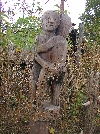 |
xThe E'de buy the dead in short,
flat-end, canoe shaped coffins (right) and celebrate
abandonment of the tomb ceremony. When the mourning is finished a ceremony
is held to abandon the tomb. The ritual involves making a funerary house
with carved statues, some sexually explicit (left and below). The E'de possess a rich and unique
treasury of oral literature including myths, legends, lyrical songs, and
proverbs. Their plastic art is unique, with patterns wove in cloth, and
particularly decorative sculptures ornamenting funerary structures and ritual
masts. Traditional religion is
polytheistic; they pray for bumper harvests and good health. The most important
rite is worshiping the Rice Spirit. |
 |
| |

|
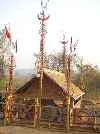

 |
 |
| |
|

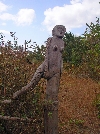 |
|
| |
 |
 The traditional religion is
animistic. There many rites related to agriculture, including a buffalo
sacrifice which uses a ritual mast (right). The traditional religion is
animistic. There many rites related to agriculture, including a buffalo
sacrifice which uses a ritual mast (right). |
 |
| |
 |
After Yangnam the road disappears
and the cycling gets better (left). Though bicycles are a common mode of
transport our guide for this section hired a soldier with a motorcycle to take
him as he showed us the way. |
 |
| |
 |
Next time through maybe we will be
able to hire one of these kinds as a guide. There is some sensitivity
about traveling in some ethnic areas so local guides are recommended. |
 |
| |
 |
A very nice feature of this route
was several miles along the Ba River. |
 |
| |
 |
Along the river some tuber was
being grown. They were bagged and ready to go to market (left). Also
in the agricultural mix was cotton (right), and |
 |
| |

|
  Agriculture
dominates the economy. Agriculture
dominates the economy. |
 |
| |

|
In the more remote areas -- areas
with sufficient forest --
rotating, cut and burn, methods of agriculture are used. As the
population increases, pressure on the land becomes more intense, but any given
plot is not allowed to stand fallow for as many years between cultivation.
Increasing the land becomes less fertile, yields drop and more land has to be
cleared -- more often. |
 |
| |

|
In addition to bicycle and
motorcycle, travel and transport here is by buffalo cart and cow with a travois. |
 |
| |

|
 This
family is digging cassava. One of the interest opportunities of digital cameras
is the ability to show people their picture (far right). God only knows
what they think of seeing their miniature image on the LED screen, but the
interaction usually gets a warm smile. This
family is digging cassava. One of the interest opportunities of digital cameras
is the ability to show people their picture (far right). God only knows
what they think of seeing their miniature image on the LED screen, but the
interaction usually gets a warm smile. |
 |
| |
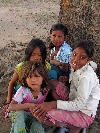 |
 And
another example of digital ice-breaking, as in sharing digital photographs. And
another example of digital ice-breaking, as in sharing digital photographs. |
|
| |

 |
Someplace in this area we changed to
the E'de or Rade ethnic community.
The E'de is a Malayo-Polynesian / Chamic group and official ethnic community in
Viet Nam. Cultivate rice and other crops using simple tools (cutlass and digging
stick), with rotational cut and burn method. New crops, grow with modern
methods include peppers, coffee, cotton, corn and cashews. The keep
livestock and poultry. There is still some hunting and gathering. |

 |
| |
 |
The chief means of transporting
goods is a woven basket with two straps. They also use elephants for
transport and travel in lower western areas. The traditional E'de family
is matrilineal. After the wedding ceremony the couple lives with the
wife’s family. |
 |
| |

|
The place to be in the afternoon is
the river side. On the far side of the river, in wells dug in the sand bar
(for filtering), the women collect water and haul it up the steep river bank and
back to the village (right). The children are under no such burden and
played for hours in the water. |
 |
| |
 |
 Back
in the village we entertained and later engaged the children with a Frisbee.
They were shy and reserved for awhile but late got fully involved and chased the
disk to all corners of the filled and occasionally beyond. Back
in the village we entertained and later engaged the children with a Frisbee.
They were shy and reserved for awhile but late got fully involved and chased the
disk to all corners of the filled and occasionally beyond. |
 |
| |

|

 In
the late afternoon, when the students returned from school, several of the
bicyclist in the village that came to see what we were doing. It would
have been helpful if our Vietnamese was better -- existent! In
the late afternoon, when the students returned from school, several of the
bicyclist in the village that came to see what we were doing. It would
have been helpful if our Vietnamese was better -- existent! |
 |
| |

|
Buildings in Pleibroum were mostly
traditional stilt-style constructions. There is a mix of both metal and
thatched roofs, but the former seems preferred. Walls are make from both
wood planks and woven mats. |
 |
| |

|
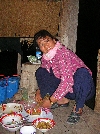 The
tradition house, and our accommodations for the night, is a long, narrow,
thatched-roof structure, build on stilts. Our amazing dinner was delivered
by motorbike to the veranda and spread before us. It included about ten
different dishes. The
tradition house, and our accommodations for the night, is a long, narrow,
thatched-roof structure, build on stilts. Our amazing dinner was delivered
by motorbike to the veranda and spread before us. It included about ten
different dishes. |
 |
| |

|
At the local watering hole, good food makes for good
conversation, both for foreign groups (left) and a local groups (right). |
 |
| |
|
| |

 |
|
    |
|
|
 |
 Please
contact us if you would like to be added to
Ibike's mailing list or have questions, comments, corrections or criticism. (Also, please let us know how you learned about us and
found this site.) Privacy policy. Please
contact us if you would like to be added to
Ibike's mailing list or have questions, comments, corrections or criticism. (Also, please let us know how you learned about us and
found this site.) Privacy policy.
 IBF Homepage
IBF Homepage  Ibike Programs
Ibike Programs
 Ibike Schedule
Ibike Schedule
 Search
Search
"Hosted by
DreamHost - earth friendly web hosting"
Created by David Mozer
Copyright ©1993-2022 Ibike LLC. All rights reserved.
|

 Photo
essay:
Photo
essay: matrilineal
but the system is fading. After the wedding a couple may go to the bride’s
parents, but they can later go to the grooms family. When a baby is one
month old, the parents hold a ceremony where the soul is introduced into the
child’s ear.








 Agriculture
dominates the economy.
Agriculture
dominates the economy.

 And
another example of digital ice-breaking, as in sharing digital photographs.
And
another example of digital ice-breaking, as in sharing digital photographs.


 Back
in the village we entertained and later engaged the children with a Frisbee.
They were shy and reserved for awhile but late got fully involved and chased the
disk to all corners of the filled and occasionally beyond.
Back
in the village we entertained and later engaged the children with a Frisbee.
They were shy and reserved for awhile but late got fully involved and chased the
disk to all corners of the filled and occasionally beyond.

 In
the late afternoon, when the students returned from school, several of the
bicyclist in the village that came to see what we were doing. It would
have been helpful if our Vietnamese was better -- existent!
In
the late afternoon, when the students returned from school, several of the
bicyclist in the village that came to see what we were doing. It would
have been helpful if our Vietnamese was better -- existent! The
tradition house, and our accommodations for the night, is a long, narrow,
thatched-roof structure, build on stilts. Our amazing dinner was delivered
by motorbike to the veranda and spread before us. It included about ten
different dishes.
The
tradition house, and our accommodations for the night, is a long, narrow,
thatched-roof structure, build on stilts. Our amazing dinner was delivered
by motorbike to the veranda and spread before us. It included about ten
different dishes.
 Please
contact us if you would like to be added to
Ibike's mailing list or have questions, comments, corrections or criticism. (Also, please let us know how you learned about us and
found this site.) Privacy policy.
Please
contact us if you would like to be added to
Ibike's mailing list or have questions, comments, corrections or criticism. (Also, please let us know how you learned about us and
found this site.) Privacy policy.![]() IBF Homepage
IBF Homepage ![]() Ibike Programs
Ibike Programs
![]() Ibike Schedule
Ibike Schedule
![]() Search
Search


